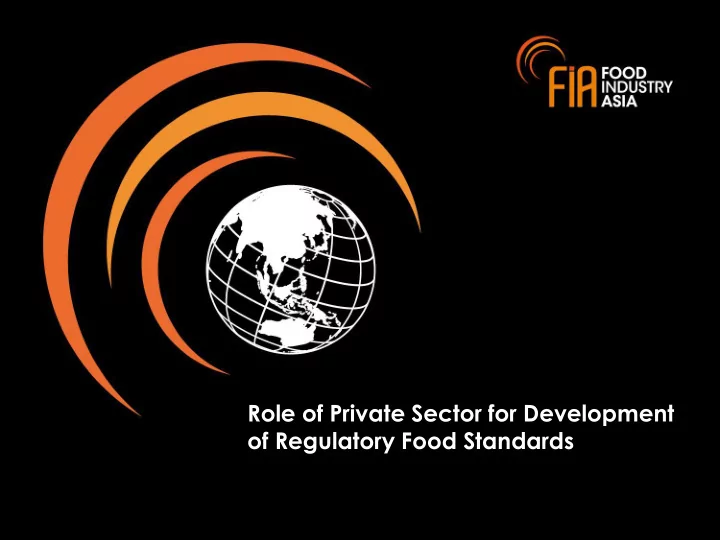

Role of Private Sector for Development of Regulatory Food Standards
OUTLINE About FIA • The Role of Private Sector in Codex Standards Setting • The Role of Private Sector in National Food Standards Setting • The Role of Private Sector in Regional Harmonnisation of Standards • Conclusions • www.foodindustry.asia 2
FIA MEMBERS www.foodindustry.asia
OUR REGIONAL NETWORK SOUTH KOREA CHINA TAIWAN INDIA THAILAND PHILIPPINES VIETNAM MALAYSIA INDONESIA SINGAPORE NEW ZEALAND AUSTRALIA www.foodindustry.asia 4
www.foodindustry.asia 5
FIA AND THE PLATFORMS www.foodindustry.asia 6
Regulatory HARMONISATION The Role of Private Sector in Codex Standards Setting 7
Codex Alimentarius Commission Established by FAO and the WHO in 1963 to develop harmonised international food standards, which protect consumer health and promote fair practices in food trade. It is referenced by the WTO Agreement on Sanitary and Phytosanitary Measures (SPS Agreement) in resolving trade disputes: WTO members that wish to apply stricter food safety measures than those set by Codex may be required to justify these measures scientifically. www.foodindustry.asia 8
Codex: The Golden Standard Key reference in developing national standards Harmonisation of standards globally Key reference in trade negotiations and disputes www.foodindustry.asia 9
Codex: A Multi-Stakeholders Approach through Members & Observers Can provide inputs to Codex (proposals, Have voting CODEX Membership Type data, positions, power comments, etc.) 187 Codex Members √ √ 186 Member Countries + EU • 234 Codex Observers √ X 54 IGOs, 164 NGOs, 16 UN • www.foodindustry.asia Source: Codex Procedural Manual 25 th Edition, Section VII: Relations with Other Organizations
Codex Procedure Step 0 • A Codex Member / Observer proposes a new work • Commission approves the new work and designate a subsidiary body Industry Inputs (through NGOs) (Codex Committee) to carry out the work Step 1 • Committee drafts the standard, usually through a working group Step 2 Step 3 • Proposed draft standard circulated for comments • Committee approves the proposed draft, and submits to the Commission for pre-approval Step 4 • Commission endorses the proposed draft standard and sends back to the Committee for further work Step 5 Step 6 • Committee continues to draft the standard and collect comments Possible to omit step 6 & 7: Called Step 5/8 • Committee approves the draft, and submits to the Commission for approval Step 7 Step 8 • Commission adopts the draft, which becomes official Codex standard www.foodindustry.asia 11
FIA in Codex FIA positions submitted to shape Codex standards. • Support countries to implement Codex standards. • Coordinate with National Codex Contact Points for alignment of regional positions. www.foodindustry.asia
Regulatory HARMONISATION The Role of Private Sector in National Food Standards Setting 13
Procedure of National Standards Setting Confirm new Planning: new Collect public standards Draft standards project proposal comments projects Approve and Revise and Re- Implementation Review draft publish evaluate and monitoring standards standards www.foodindustry.asia 14
SPS & TBT Notifications for WTO Members National Governments • notifies WTO about new draft regulations WTO members may give • comments to the draft regulations Commenting period is • usually 60 days. www.foodindustry.asia 15
FIA Tool: Regulatory Monitoring & Mapping www.foodindustry.asia
Industry Contributing to National Standards Setting Industry positions, comments submitted to national authorities • www.foodindustry.asia
Regulatory HARMONISATION The Role of Private Sector in Regional Harmonisation of Standards 18
Regulations v.s. Non-Tariff Barriers to Trade Non-tariff measures increasing in prominence • and complexity in all countries. NTBs include opaque rules, arbitrary standards • that are not based in science, and Customs and other import procedures that are slow, costly and excessive. Among all NTBs, Technical Barriers to Trade ( TBT ) • and Sanitary and Phyto-Sanitary ( SPS ) measures are found to be the most burdensome. The various barriers can raise food prices, • undermine food quality, impact on food availability and impose extra burdens on small businesses. The foremost recommendation is to improve • communication between stakeholders. Use consensus building to drive public-private • partnership to reduce uncertainty. www.foodindustry.asia 19 Source: ABAC Report, November 2016
Opportunities in ASEAN Regional Integration 3 rd 2 nd Population Fastest-growing economy CHINA 1,340 INDIA 1,195 ASEAN 625 EU 502 USA 310 JAPAN 128 A single market and production base Source: ASEANStat, IMF, WB A highly competitive economic region A region of equitable economic development A region fully integrated into the global economy www.foodindustry.asia 20 20
The Need for Regulatory Convergence “Indonesia’s food and beverage associations foresee no significant change in the business landscape unless standards and regulations are harmonised ”. - Adhi Lukman, Chairman, GAPMMI Source: http://www.thejakartapost.com/news/2016/01/04/food- beverage-industry-indifferent- aec.html#sthash.BQPv7yoo.dpuf www.foodindustry.asia 21
Example: Regulatory Status for Sweeteners in Different Countries www.foodindustry.asia 22
Example: Three difference Nutrition Information Panels (NIPs) on the same package www.foodindustry.asia 23
Top 5 Priority TBTs for the food industry to Overcome in ASEAN 1. Labelling (nutrition labelling) 2 . Product registration 3. Import/Export Certification 4. MRLs for contaminants, pesticide residues 5. Analytical Methods www.foodindustry.asia
How is Industry Mitigating These Challenges? www.foodindustry.asia 25
Driving Harmonisation in ASEAN Registered in Singapore AFBA White Harmonisation Paper on of nutrition Presented at 19 th AEC Harmonisation FOP GDA labelling in PFPWG Meeting, Launch of the ASEAN Scorecard for Accreditation to Nutrition ASEAN Bangkok Food & Beverage Agri-food ASEAN Labelling Alliance (AFBA) sector Guideline 2013 2014 2015 2016 • Harmonisation Report Mapping ASEAN SMF-AVA • 4 Case studies nutritional Position paper to Position to ASEAN MRA Annual published as fact labelling ASEAN General for Inspection and sheets Dialogue regulations Standard for the Certification on Food Singapore Labelling of Pre- Hygiene for Prepared packaged Foods Foodstuff Products www.foodindustry.asia 26
CONCLUSIONS Private sector plays a key role in national standards setting • National regulatory standards not only affects domestic products, • but also affects trade International / Regional harmonisation of regulation is important for • economic integration Capacity building and information exchange through public-private • partnership are essential for effective implementation and better convergence of regulations www.foodindustry.asia 27
THANK YOU
Recommend
More recommend